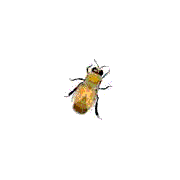


Wax
Although Harvesting and selling virgin bees wax isn't very
profitable, making stuff out of bees wax can be a lot of fun
and can save you some money in the long run. Besides the
obvious dipped and molded candles, did you know you can make
over a hundred different household items out of bees wax?
There's a real handy book out called Super Formulas by
Elaine C. White that tells how to make more than 360 useful
products that contain honey and beeswax. A book, no beekeeper
should be without. There are recipes for everything from
Adhesives to Wood Finishes.

This is not to say making candles isn't fun. There's nothing like
making tapered candles for the dinner table in much the same way our
great grandparents did, way back when. The nostalgic aroma of bees
wax will fill the house as you dip your wick in and out of the
melted wax, building layer upon layer until it's just the right size
for your favorite candle holders. A oil soluble coloring can be
added to your wax if you wish, but bees wax can come in many
different natural colors of it's own. New wax is almost pure white.
As honey and pollen are collected and stored in the comb, the wax
becomes stained and contaminated with impurities. I have seen wax
collected in all shades of creamy white to bright yellow, and from
golden tan to rich brown. Once the wax has set in the hive for a
while, it starts to turn kacky in color and eventually black. At
this point, it's best to bleach the wax using peroxide, or better
yet sell it off to places that buy bees wax.

Did you know that all natural bees wax burns brighter than
processed/treated/synthetic paraffin used to make candles now
days?

What is wax anyway? When you or I eat lots of honey we get fat. Our
bodies metabolize the sugars in honey and convert them into fat
molecules. In the same way our bodies metabolize honey, so does the
bee, except instead of making fat, the honey bee converts the sugars
into wax. The wax is then secreted out specialized glands from under
the bees abdomem. If the wax is needed to make comb, then the bee
removes the wax and chews it up and moldes into the shape of the
honeycomb.
Tree sap is sometimes added to the wax to form what is called
propolis. Propolis is much more pliable than wax and is used by the
bees to seal holes in their hive and 'glue' the hive together.
Although there is no research to prove it, propolis is believed to
have medicinal properties, and is used for a variety of ailments.
 Back to my Bee Page
Back to my Bee Page
 Back to my Home Page
Back to my Home Page

 Send E-Mail to orchids@geocities.com
Send E-Mail to orchids@geocities.com


For more information on this web page please contact Web
Master Andy at:
orchids00001@yahoo.com
Home page URL:http://geocities.datacellar.net/RainForest/3297/index.html
© 1996


Garden Page Award

This page hosted by:

Get your own Free Home Page








 Back to my Bee Page
Back to my Bee Page
 Back to my Home Page
Back to my Home Page

 Send E-Mail to orchids@geocities.com
Send E-Mail to orchids@geocities.com





